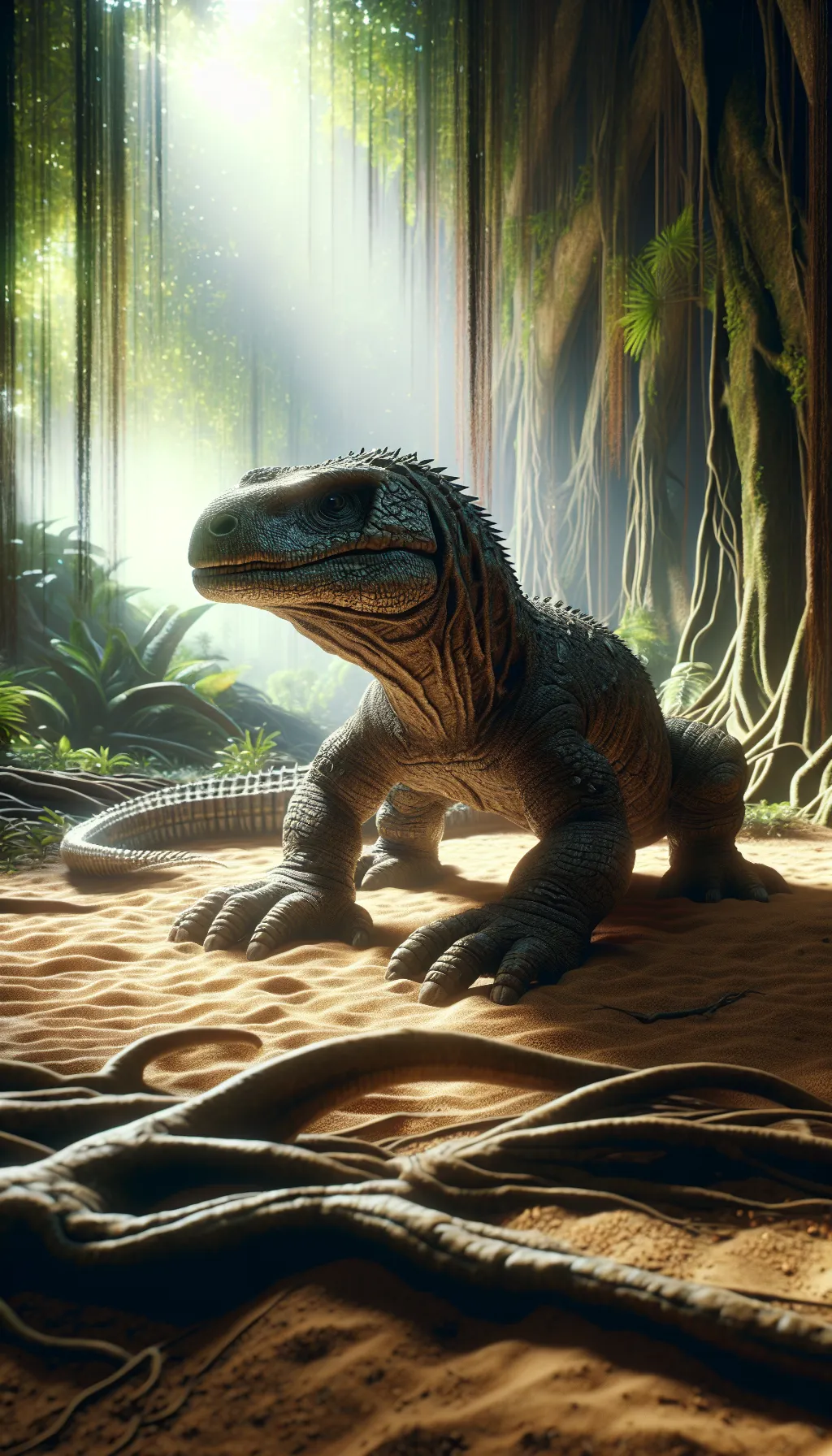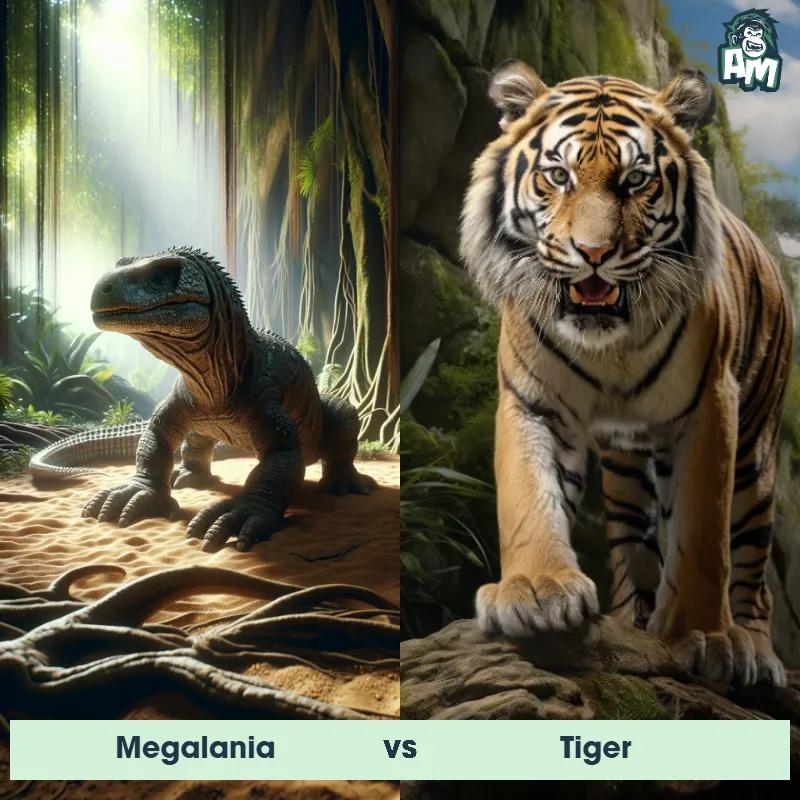The Megalania
Megalania, also known as the Giant Ripper Lizard, was a massive prehistoric monitor lizard that roamed Australia during the Pleistocene era. It was one of the largest lizards to have ever existed, reaching lengths of up to 23 feet and weighing over 1,300 pounds. Megalania had robust limbs, sharp teeth, and a powerful tail, making it a formidable predator in its environment.

| Megalania | |
|---|---|
| Size | Up to 23 feet in length (7 meters) |
| Weight | Over a ton (907 kilograms) |
| Speed | 19-24 mph (30-39 km/h) |
| Key Strength | Powerful bite |
| Biggest Weakness | Slower movement due to size |
| Scientific Name | Megalania prisca |
| Family | Varanidae |
| Habitat | Woodlands and open forests |
| Geography | Australia |
| Diet | Large mammals |
| Lifespan | 35 years - 50 years |

The Megalania
Megalania, also known as the Giant Ripper Lizard, was a massive prehistoric monitor lizard that roamed Australia during the Pleistocene era. It was one of the largest lizards to have ever existed, reaching lengths of up to 23 feet and weighing over 1,300 pounds. Megalania had robust limbs, sharp teeth, and a powerful tail, making it a formidable predator in its environment.
Fun Fact: Megalania is believed to have been an apex predator, capable of taking down large prehistoric mammals such as Diprotodon, the giant kangaroo Procoptodon, and even other Megalania individuals.
| Megalania | |
|---|---|
| Size | Up to 23 feet in length (7 meters) |
| Weight | Over a ton (907 kilograms) |
| Speed | 19-24 mph (30-39 km/h) |
| Key Strength | Powerful bite |
| Biggest Weakness | Slower movement due to size |
| Scientific Name | Megalania prisca |
| Family | Varanidae |
| Habitat | Woodlands and open forests |
| Geography | Australia |
| Diet | Large mammals |
| Lifespan | 35 years - 50 years |
Megalania Matchups
We use AI to simulate matchups between the Megalania and other animals. Our simulation considers size, strength, and natural predatory behaviors to determine the most likely outcome.

Can't find the Matchup you want?
Create Your Own MatchupMegalania: Diet, Predators, Aggression, and Defensive Behaviors
What did Megalania eat?
Megalania were believed to have been carnivorous, meaning they primarily ate meat. Fossil evidence suggested that they may have preyed upon a variety of animals, including large mammals, birds, and other reptiles. Their diet likely consisted of the animals that inhabited the same environments as them during the Pleistocene era.
Did Megalania have any predators?
As apex predators, Megalania likely had few natural predators due to their large size and strength. However, they may have occasionally faced competition from other large predators, such as marsupial lions, thylacines, or other Megalania individuals. In general, Megalania were at the top of the food chain in their ecosystem.
Were Megalania aggressive?
Megalania are believed to have been ambush predators, meaning they likely stalked and attacked their prey opportunistically. While their behavior towards other creatures is speculative, it is assumed that they were aggressive when hunting for food. However, their overall behavior towards other Megalania or potential threats is not definitively known.
Did Megalania fight?
Megalania, like other predators, would have likely engaged in territorial disputes or competition for mates, which may have led to conflicts between individuals. Additionally, when hunting or defending themselves, Megalania may have fought with their prey or other predators in the area. Their sharp teeth and strong jaws would have been formidable weapons in any potential fights.
How did Megalania defend themselves?
Megalania likely relied on their size, strength, and sharp claws and teeth for defense against potential threats. When faced with danger, they may have used their powerful jaws to deliver crushing bites or their claws to slash at attackers. Additionally, their well-developed senses, including sight and smell, would have helped them detect and avoid threats in their environment.
What was Megalania's biggest weakness in a fight?
Despite their formidable size and strength, Megalania may have had a vulnerability in their relatively slow speed and agility compared to some of their prey or potential predators. Additionally, their massive size would have required a significant amount of energy to sustain, possibly making them more vulnerable to exhaustion during prolonged fights.
Fun Fact: Despite its massive size, Megalania was agile and fast, able to chase down its prey with relative ease due to its powerful limbs and sharp teeth.
Fun Fact: The extinction of Megalania is commonly attributed to the arrival of humans in Australia, with some evidence suggesting that the species may have coexisted with Aboriginal populations for a brief period before disappearing.











